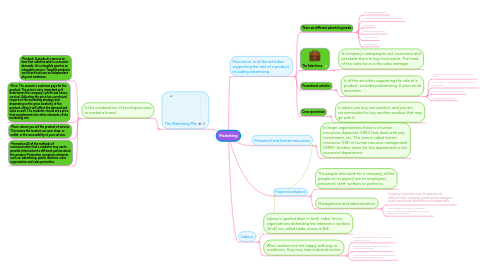
1. The Marketing Mix
1.1. Is the combination of tecnhiques uses to market a brand.
1.1.1. -Product: A product is seen as an item that satisfies what a consumer demands. It is a tangible good or an intangible service. Tangible products are those that have an independent physical existence.
1.1.2. -Price: The amount a customer pays for the product. The price is very important as it determines the company's profit and hence, survival. Adjusting the price has a profound impact on the marketing strategy and, depending on the price elasticity of the product, often it will affect the demand and sales as well. The marketer should set a price that complements the other elements of the marketing mix.
1.1.3. -Place: where you sell the product of service. This means the location our your shop, or outlet, or the accessibility or your service.
1.1.4. -Promotion:All of the methods of communication that a marketer may use to provide information to different parties about the product. Promotion comprises elements such as: advertising, public relations, sales organisation and sales promotion.
2. Promotion: Is all the activities supporting the sale of a product, including advertising.
2.1. There are different advertising media
2.1.1. -Classified advertisements.
2.1.2. -Open air hoardings (BrE)/Bilboards (AmE)
2.1.3. -Neon signs
2.1.4. -Display advertisements
2.1.5. -Tv commercial
2.1.6. -Special display
2.2. The Sales force
2.2.1. A company's salespeople visit customers and persuade them to buy its product. The head of the sales force is the sales manager.
2.3. Promotional activitie.
2.3.1. Is all the activities supporting the sale of a product, incluiding advertising. A promotiob describes:
2.3.1.1. A special offer: such as a discount or reduced price.
2.3.1.2. A free sample: a small amount of the product to try or taste.
2.3.1.3. A free gift: given with the product.
2.3.1.4. Competitions with prizes.
2.4. Cross-promotion
2.4.1. Is where you buy one product, and you are recommended to buy another product that may go with it.
3. People and workplaces.
3.1. The people who work for a company, all the people on its payroll, are its employees, personnel, staff, workers or worforce.
3.2. Management and administration.
3.2.1. Company´s activities may be spread over different sites. company´s most senior managers usually work in its head office or headquarters.
3.2.2. Some managers have their own individual offices, but in many businesses, most enloyees work in open-plan offices.
4. Labour
4.1. Labour is spelled labor in AmE. Labor Union, organizations defending the interests o workers (AmE) are called trade unions in BrE.
4.2. When workers are not happy with pay or conditions, they may take industrial action:
4.2.1. A strike, stoppage or walk-out: workers top working for a time.
4.2.2. A go-slow: workers continue to work, but more slowly than usual.
4.2.3. An overtime ban: workers refuse to work more than the normal number of hours.
